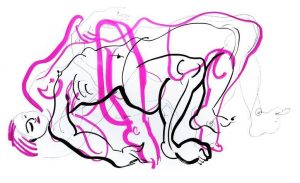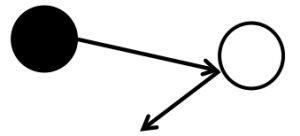Jumping Wild (Upd: Jun 13, ’22)
Jumping Wild is a term coined by Rhizome Lee.¹ Despite what the name suggests, this practice is not about physically jumping but jumping from qualia to qualia. This dance involves perpetually shifting qualias. As soon as we begin to settle into one movement or qualia, we switch to another. Jumping wild is the qualia of qualias. Jumping Wild is a natural result of becoming shisha (dead) or entering the multi-dimensional world, goal of butoh.

In a way, Jumping Wild is like Attention Deficit Hyperactive Disorder* which we can use to our advantage as a tool. The more one can shift attention from qualia to qualia, the better. Better yet, if we focus, can enter deeply into one qualia, instantly drop it, and then again enter deeply/have 100% presence into another qualia, this is the most ideal. Is this a moment of both concentration and distraction paradox or concendistraction? Can the intricate also be chaotic or intrichaotic?
This concept of entering and leaving is also taught by Peter Brook called to be and not be.² It requires a double resonance of Stanislavski-esque re-experiencing one’s experiences while at the same time being distanced from the experience. A deep situation can be dropped so quickly because of this double resonance.
To Rhizome Lee, this double resonance involves becoming a transparent Riken, watching oneself from the outside during performance (and maintaining 50% inside and 50% outside).4 This double resonance is also called coolness by Yukio Waguri and not drunk by Yukio Makami.5 Additionally, Stephen Wangh (a pupil of Jersy Grotowski) called it the third paradox of acting, where the inside and the outside are to have equal attention.8
One trick to reach this transparent Riken is to keep the breath at a steady pace throughout no matter how quickly or sporadic one is changing worlds. This trick is emphasized by the theatre guide Celal Mordeniz.**
To Sri Sri Ravi Shankar: “Do anything with 100% and you will be able to drop it effortlessly. . . . When you can drop and quit in a moment, without getting frustrated, . . . you have retired back to the Self.”³
Getting lost in the dreamscape is recommended. One qualia can make one feel another qualia, so one travels there, followed by another. This is the general concept of rhizoming. The implications can extend to shifts in context as well, recontextualization which can also be viewed as double images, puns, and reframing. Utilizing the ‘pataphor is also an excellent mode of shift.
Exercise 1: Throwing Qualias
In order grow accustomed to the idea of shifting, we can have one or more participants in the performance space while one or more others speak out varying person, place, thing, or idea qualias. The performers are to perform these qualias on-the-spot no matter how quickly they come.
Exercise 2: Rejecting Thrown Qualias
Like the first exercise, there is an instant shifting based off of what is being thrown out. This is the opposing version, however, where any kind of qualia is immediately entered into so long as it is not the thrown out qualia or the prior qualia. Essentially, this is an exercise of cultivating movement non sequiturs, even though everything always comes from something, but perhaps the observer may not notice where.
Exercise 3: Throwing Jo-Ha-Kyus
This exercise plays with the same concept, except now one person throws out various Jo-Ha-Kyus one at a time (first Jo, then Ha, then Kyu). Examples: question, thesis, conclusion / inadequate, adequate, too much / sensation, action, result / birth, life, death.
Exercise 4: Fifth Dimensional Movement
This exercise begins with a form of vaporizing. While in statue or ash body, we visualize/feel our very selves flooding the space, some of us sitting, dancing, and/or engaged in various cobodies. We see so many of ourselves till it is as crowded as a Tokyo subway train. Then gradually break out of ash body vaporization and fit into these other versions of yourself like a glove. Do not stay in one glove or mold though. Continually shift from one to another.
Exercise 5: Multi-Qualia Dimensional Movement
Exercise 6: Prop Metamorphosis
While using a prop, continually shift the context or qualia of the prop. For instance, a balloon can shift into a bomb, a head, a world, or an egg. Kazuo Ohno made use of this idea from his performance entitled “My Mother.” The table shifted into endless relationships of him and his mother. The table was his mother.
Exercise 7: Throwing Prop Qualias
Somebody throws out arbitrary qualias and the person must utilize or transform their prop to work with the qualia. The more seemingly different the qualia is to the prop, the better.
Exercise 8: Changing Qualia Walk
Every step is a new qualia. This is a walk of shifting qualias. Make sure the qualia affects each step.
Exercise 9: Character Prop Shift
This is a cobody exercise where Character A gives a prop in one context to Character B but Character B has a different context for it.
Exercise 10: Character Jumping Wild
There are quick and constant character transitions.
Exercise 11: Vaporized Ash Body
This is an exercise that looks very subtle on the outside, but not within. On the outside, we are in ash body, but within we are shifting through endless qualias in the invisible multidimensional world.
Exercise 12: Vaporized Opposition
There are opposing states between the 3d world and the invisible multidimensional world. If our 3d body is frozen, then the invisible world is moving, whether with one or many of us or with differentiating qualias. If our 3d body however is moving, then the invisible multidimensional world is frozen.
Exercise 13: Qualia Aversions
This exercise requires a list to be made of all qualias that leaves the participant with distaste (whether persons, places, things, or ideas). Once a list is made (the larger the better), somebody throws them out at random so that the participant can resonate with them.
Exercise 14: Strictly Novel
This is an exercise in only entering into new or novel qualias. If it is something that you have already felt or done before in dance, immediately discard it and search for another qualia. This is a very important exercise for conditioning oneself to allow for fresh creations.
Exercise 15: Drastic World Changes
This exercise places special attention on shifting from worlds that are completely different from each other. The more different the worlds from each other, the better. For instance, it would be too similar to jump from the world of beach sand to the world of seagulls. These two already share many associaitons/qualias. What if instead you go from seagulls to ink pads?

Contemporary Metaphor Theory
In terms of contemporary metaphor theory, jumping wild would be classified as a type of FORCE schema known as the DIVERSION schema.6 Image schemas to Lakoff and Johnson are “recurrent patterns in perceptual-motor experience that derive from our bodily interaction with the physical world.”7 To SIL Glossary of Linguistic Terms, a diversion schema is “a force schema that involves forces that physically or metaphorically meet and produce a change of direction.” An example is a boat being taken off course by wind, but any qualia can be “taken off course” by any other qualia.
Like so many other image schemas, we are bombarded with this schema at so many moments of our lives.